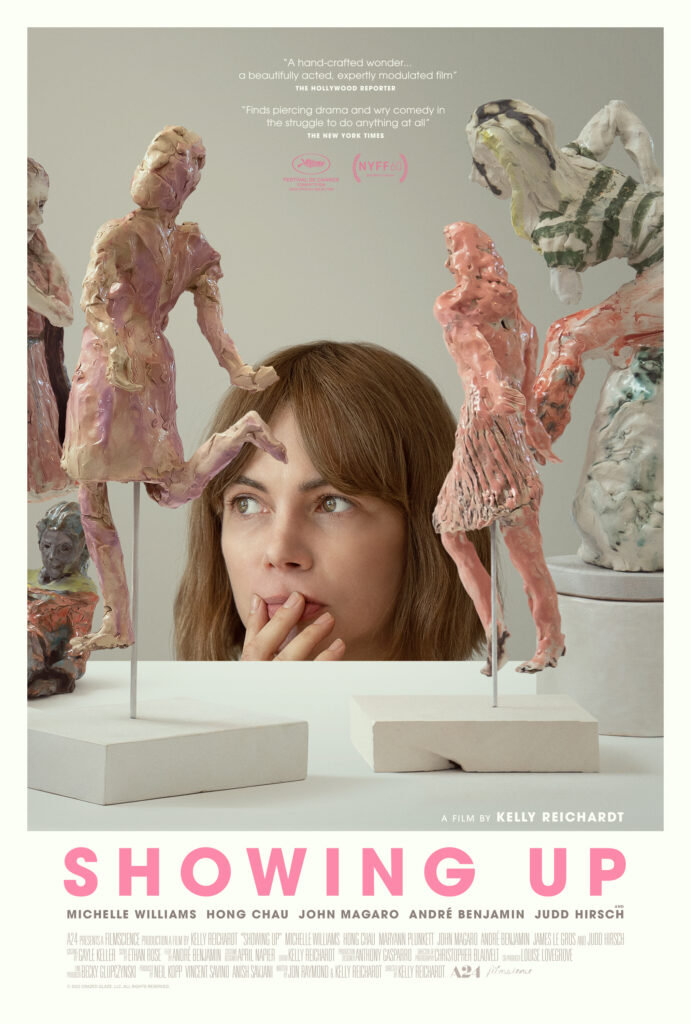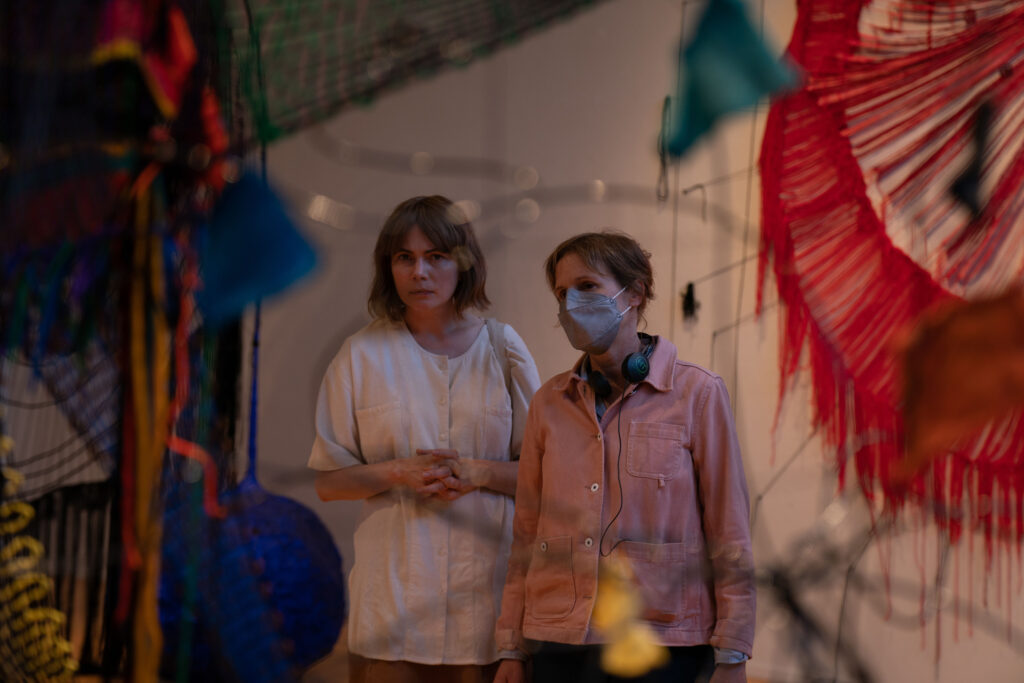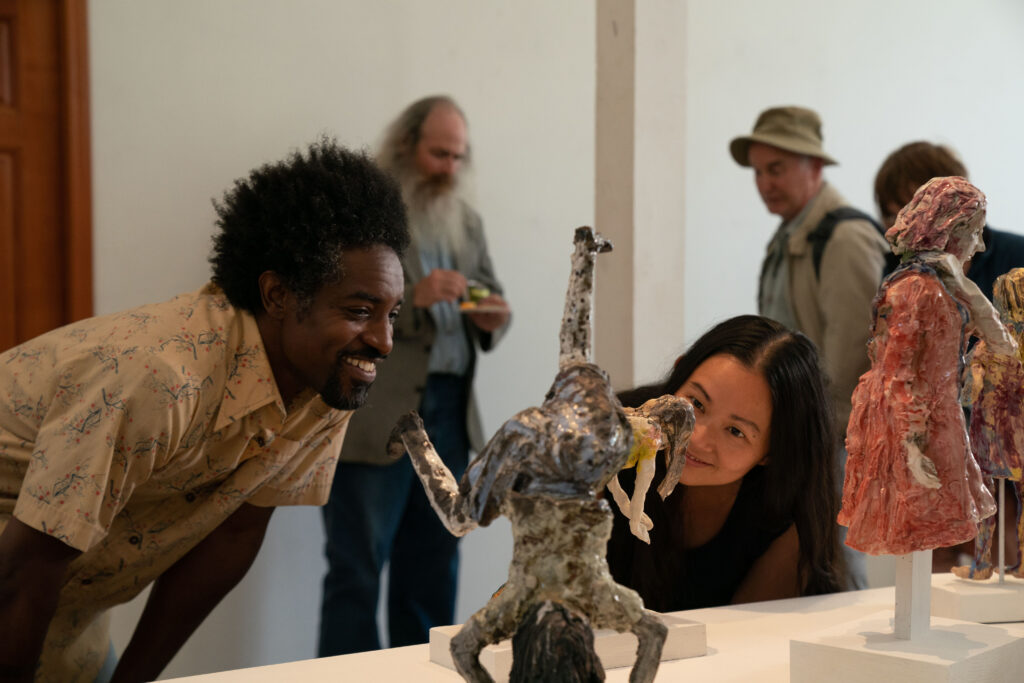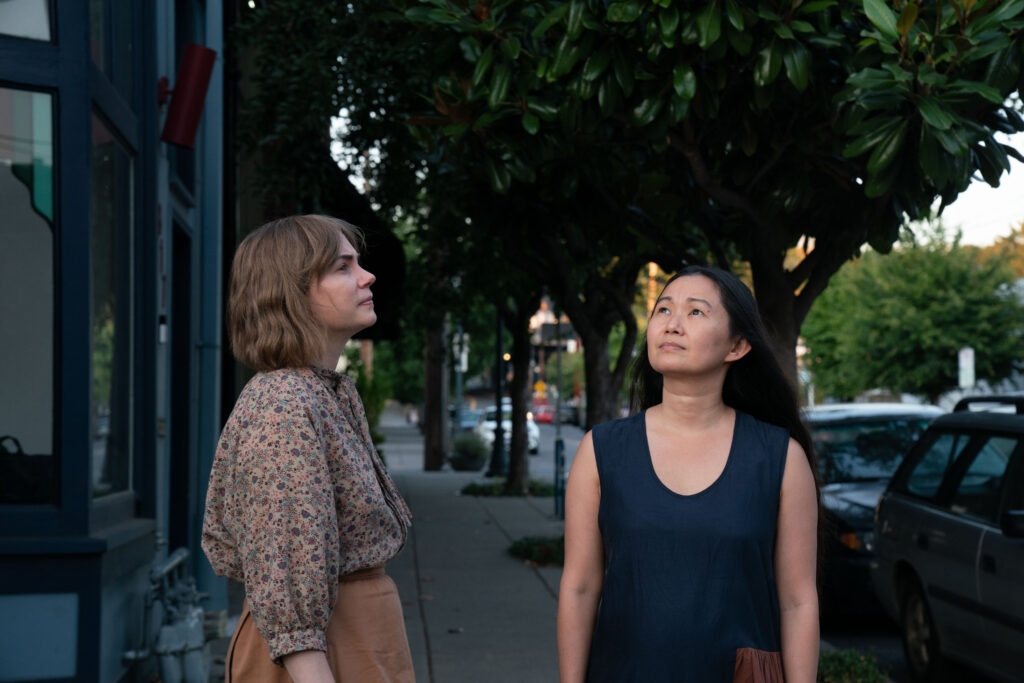By Kirsten Coachman
With a week to go before what could be a career-changing exhibition, all Lizzy (Michelle Williams) wants is to finish her final ceramic sculptures and for her hot water to finally be fixed.
“Showing Up,” the latest film from Writer/Director Kelly Reichardt, opens in San Francisco this weekend. It’s Reichardt’s fourth project with Williams, who previously appeared in “Certain Women” (2016), “Meek’s Cutoff” (2010), and “Wendy and Lucy” (2008).

Set in Portland, Oregon, “Showing Up” follows Lizzy, a ceramics artist, as she navigates a week of distractions—from family and fellow artists to those of her own making. The film is a fascinating portrait of being part of a community of artists and underlying competition that can both fuel and inspire creativity.
The film first premiered in 2022 at the Cannes Film Festival. In addition to Williams, “Showing Up” stars Hong Chau (“The Menu”), Maryann Plunkett (“Little Women” [2019]), John Magaro (“First Cow”), André Benjamin (“Four Brothers”), and Judd Hirsch (“The Fablemans”).
Reichardt was recently in the Bay Area for Berkeley Art Music and Pacific Film Archive’s (BAMPFA) recent program, “Kelly Reichardt in Person.” Art U News had the opportunity to sit down with the filmmaker as part of a media roundtable to discuss her new film, the evolution of her ongoing collaboration with Williams, working with local Portland artists, and if she prefers one creative hat over another.
“Showing Up” is probably the most directly maybe self-reflexive work that you’ve made as a filmmaker. What particularly inspired you to create such work at this point in your career?
Yeah. Is it the most—yeah, I’m not in there. I’m not in that mix.
You wouldn’t say you are at all?
No. I don’t know. Yeah, sure. As much as all of ’em and none of ’em, I guess. You know, the art school in the movie is the Oregon College of Art and Craft, and it’s this important institution in the Pacific Northwest for ceramics and pottery. [And it] sadly closed its doors in [2019]. And the overall closing of art schools was something we thought, “Wow, it would be awesome to shoot in this space before it’s gone or becomes whatever it’s gonna become.” And we had been thinking about making a film about art-making or an artist bio for a while. And it took a bunch of different turns, and we were sort of reaching further away, and then we ended up in our own kind of backyard of Portland and drawing from worlds that we both—Jon Raymond and I—both know quite well in artists’ lives and shooting on a block that a bunch of our friends live on and have lived on for off and on and at the school where we know many people that have worked there and in a variety of ways have histories in that school.
And, like you’re saying, it somehow circled back to a more personal film than was intended. But it was cool, ’cause I’ve been teaching for such a long time—and still teaching—it was nice to sort of have those worlds collide with each other.

You’ve worked with Michelle Williams now multiple times. How did you know that she was going to be somebody that you’d want to work with over and over again? And how has your working relationship evolved from film to film?
I mean, I just work on one film at a time, so there’s not a roadmap to the future. With Michelle, she’s great to work with, and if there’s a part that works for her—and she’s available—it’s a great lucky thing. And it evolves ’cause she’s off working all the time, you know, or I’m making films, and then we come back together. And I kind of get the benefit of all the work she’s been doing since I last saw her. But I guess it’s just evolved ’cause we’ve both gotten older and are more practiced at what we do. I mean, I think she’s working on a different level, and it was really fun.
And so it always feels different in that sense ’cause years pass in between. She’s always been a very trusting collaborator from the beginning, and that’s just a very fortunate, generous thing on her part and makes it really fun to work with her. I think we both enjoy it. If you do good work together and sometimes it’s a painful collaboration, and sometimes it’s not. And this is a not-painful one. [Laughs]
You mentioned at the screening yesterday (Friday, March 24) that the sort of fraught dysfunctional family dynamics—some of the nuances of that—was kind of created organically on set in collaboration with the actors. You know, talking a bit about how Judd Hirsch sort of redid each take in a new way. How much of your directing and screenwriting work, particularly in “Showing Up,” relied on this sort of improvisational collaboration?
It’s not [improvised]. It’s all scripted. It’s just a matter of, like, you don’t really know how people are gonna play off each other until they’re doing it. Especially when they’re in their part, so it plays one way on the page, and then it comes to life in a way that, between all of them, it can be really different each time. But it’s not improvised. I’ve never really done much improvisation. But yeah, it comes to life, and it’s going to be different than how you imagined it because they’re people with their own voices and ideas and inflections and where they see the moment being or the tone, and Judd’s really versatile. And so whenever he changes, it’s not that he’s changing the dialogue, but he just changes where the emphasis is or something like that, or a glance or whatever, then everyone’s different, ’cause everyone is responding to what’s happening.

I read that André Benjamin took an avid interest in working with a kiln prior to filming. So I was wondering what that means to you when you’ve written this character that does this work, and then you have your actor take a genuine interest in it, and how do you see it kind of enriching their performance while you’re filming?
Well, it would be weird if an actor wasn’t interested. You’d be in trouble, you know? But I’m just very curious. I mean, it’s not like I know André so well, but he seems just so curious about learning everything. Like if you just left him at that school, he’d do everything. And he’s a visual artist also. He draws—he’s got a hand in everything, so that was great. We sent him to learn the kilns at Cal State, and he just was like, “Whoa, clay, great. Alright.” [Laughs] Like, “Alright, cool.” He likes diving in and absorbing. And Michelle was working with Cynthia Lahti, and Hong was working with Michelle Segre, the artist whose her work is [in the film]. So everyone—and all the students that came—were learning from each other and learning from the young artists in Portland we hired to make work for the school.
So everybody was learning off each other. And who knows where inspiration starts or finishes? Actors go through their own process that isn’t even happening around me. But you give people a lot of stuff to do. … It’s like the focus isn’t on dialogue or whatever. It’s like, “I have to pour this boiling water in this pot, so I have to pay attention to what I’m doing here.” And I think it helps the dialogue and what’s going on to be secondary, and that’s nice, and I think that actors like that, maybe.

You’ve discussed how much of the joy of “Showing Up” was in having the work of Portland-based artists and their pieces featured throughout the film. You shot much of the film at the now-defunct Oregon School of Arts and Crafts, filling its classroom spaces with artists and their artwork. How was this process of working with these local artists?
We filled the school. A lot of that had to do with the art department. Tony Gasparro, the production designer, was bringing in local artists and recent art school graduates. We worked with PICA out in Portland to try to find people and also our casting person who does the—I hate the word background, ’cause nobody’s really background, they’re all in there—Simon Max Hill was out searching for recent graduates, art school people. A lot of people are hanging around ’cause it was Covid and were available.
There was this one room of like four women that were there for a really long time churning stuff out, just making stuff. It just was like the most fun room in the pre-production. Like, if you wanted a lift in your day, you’d go in. They’re just listening to music and making art. It seemed like such a happy place to be. [Laughs] Then it just sort of grew and kept growing, ’cause the kids that came in that were the actors were learning stuff. And the woman at the end of the film, who was doing the knotting in the credits, was our head PA, and she knew how to do the looms, and our loom person got Covid and couldn’t come. So she ended up teaching everybody how to [do it].
And a lot of people that worked on the film had history at that school. Dale—the ceramics [studio] was still open ’cause [there were] still outside classes happening there—he helped us a great deal, and he’s a ceramicist, and his stuff got in the film. It just took on this life. Listen, spaces are expensive. If you tell any artist they can come make stuff in a room, and you give them space, they’re like, you know, bees to honey.

As somebody that wears different creative hats on this film—from writing to directing to editing—do you have a preference for one over the other? Or is it like picking a favorite child?
No—yeah, maybe. I like collaborating. There are parts of writing I really like, and I’ve had a long collaboration with Jonathan Raymond, and that’s cool. Production is hard. I really enjoy pre-production up to a point before the one day you wake up, and the full stress suit is on. But before that happens, I love working with [cinematographer] Christopher Blauvelt, and I guess my favorite part is figuring out how I’m going to tell a story visually. I like that. And then I work with Chris, and that’s awesome. And there’s lots to figure out when, ’cause again, it’s all on paper, and then I get with Chris, and we’re on a location with a viewfinder, and it’s a whole new conversation. And then actors come to it, and the conversation changes again.
And then you get in the editing room, and it changes again. And getting in the editing room was great. Like, you’ve done your hard work, now you have really the longest period, and you’re more on your own. You don’t have to get up at the break of dawn; the pressure’s off. Like the shooting has a lot of magical, great moments and is stressful [laughs], in a word. So, that process could not go on longer than it does. But it’s also maximum challenging.
“Showing Up” is now playing in San Francisco. This interview has been edited for length and clarity.
